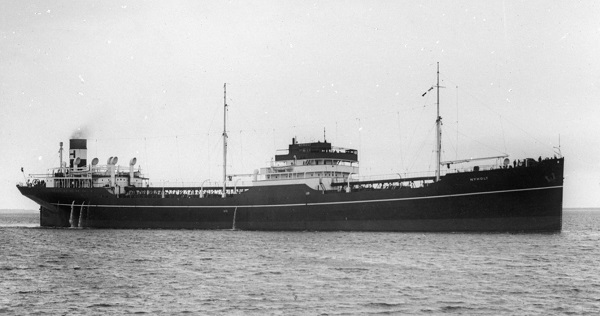Nyholt
Norwegian Motor tanker

Photo courtesy of Karmsund Folkemuseum
| Name | Nyholt | ||
| Type: | Motor tanker | ||
| Tonnage | 8,087 tons | ||
| Completed | 1931 - Odense Staalskibsværft ved A.P. Møller, Odense | ||
| Owner | Christian Haaland, Haugesund | ||
| Homeport | Haugesund | ||
| Date of attack | 17 Jan 1942 | Nationality: | |
| Fate | Sunk by U-87 (Joachim Berger) | ||
| Position | 45° 46'N, 54° 18'W - Grid BB 9855 | ||
| Complement | 41 (20 dead and 21 survivors). | ||
| Convoy | ON-52 (dispersed) | ||
| Route | Reykjavik - New York | ||
| Cargo | Ballast | ||
| History | Completed in April 1931. Since 1940 in Admiralty service as Royal Fleet Auxiliary (RFA). | ||
| Notes on event | At 03.59 hours on 17 January 1942 the unescorted Nyholt (Master Alf P. Andersen), dispersed from convoy ON-52, was hit amidships by one torpedo from U-87 about 180 miles south of Cape Race. The explosion destroyed three tanks on her port side, but she remained afloat and tried to get to Newfoundland. The U-boat had difficulties to hit the wild zigzagging tanker and missed with four torpedoes at 04.04, 04.08, 04.55 and 05.34 hours. While reloading the tubes, the tanker tried to ram the U-boat and both ships turned in circles near to each others until the stern tube was reloaded. The stern torpedo was fired at 08.21 hours and hit the ship amidships on the port side, followed by a bow torpedo four minutes later, but the last torpedo fired at 08.26 hours missed and the U-boat had to sink the ship with the deck gun after the crew abandoned ship in two lifeboats. 120 rounds were fired between 09.02 and 09.35 hours, of which about 70 were hits. When the Nyholt was abandoned, the master and two men fell overboard and only the master could be rescued by one of the lifeboats. The first engineer died on the second day, his wool sweater was given to someone who had none and the lifeboats became separated during a storm around 21 January, one of them with 13 crewmen, one passenger and one gunner in it was never seen again. The motor boat with 24 survivors was spotted by a Hudson aircraft nine days after the sinking, just as they were about to bury a crew member, who died in the lifeboat. The aircraft dropped two lifevests containing two thermoses with warm liquids, apples, oranges, cigarettes and some sandwiches of the aircraft crew. The survivors were later picked up by HMCS St Clair (I 65) (LtCdr D.C. Wallace, RCNR) and landed at Halifax on 27 January. The master died on board of the destroyer, while a passenger (the former first engineer of Taranger) died at a hospital on 5 February. | ||
| More info | |||
| On board | We have details of 40 people who were on board. | ||
If you can help us with any additional information on this vessel then please contact us.
